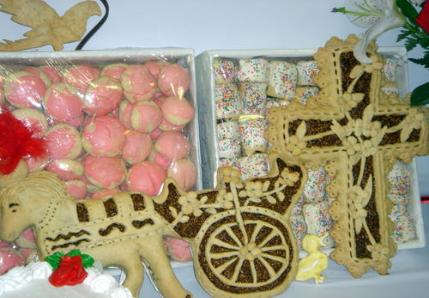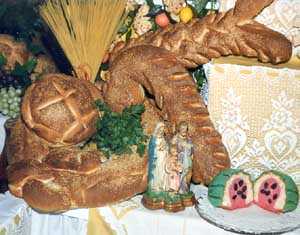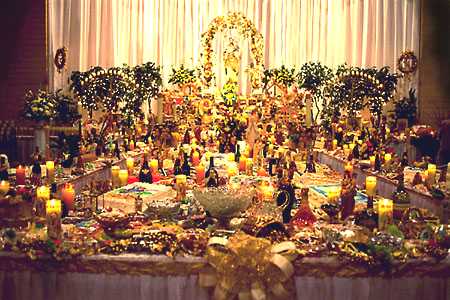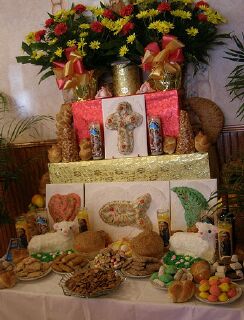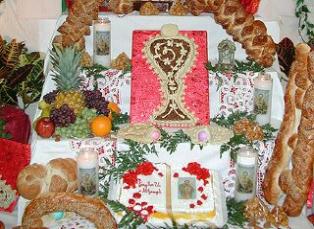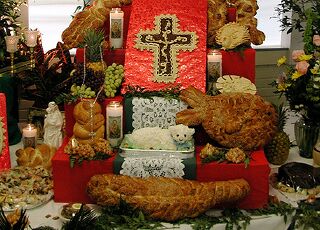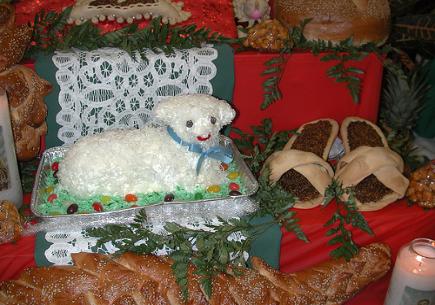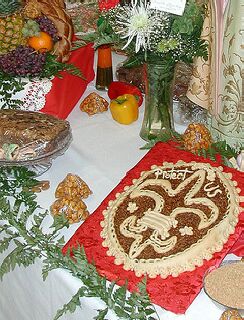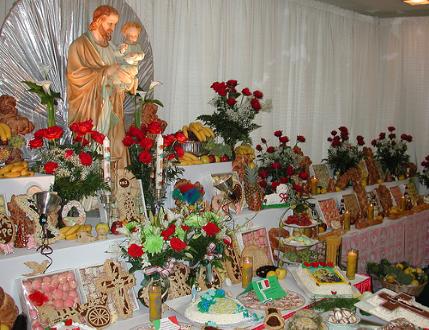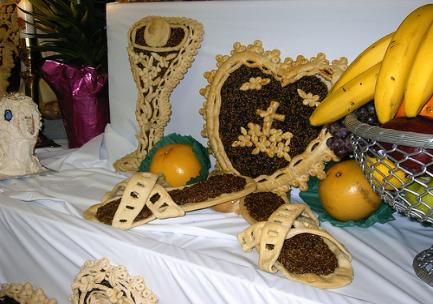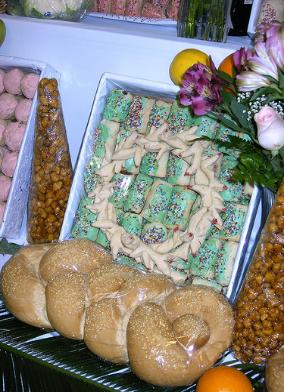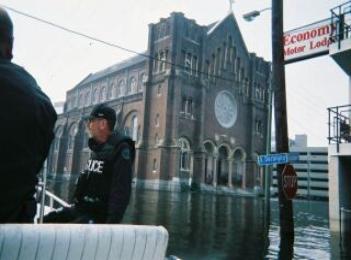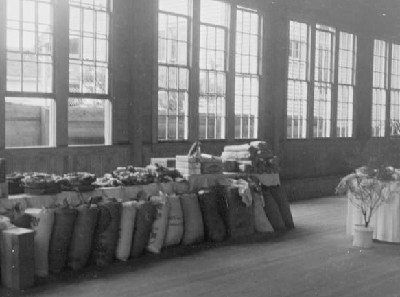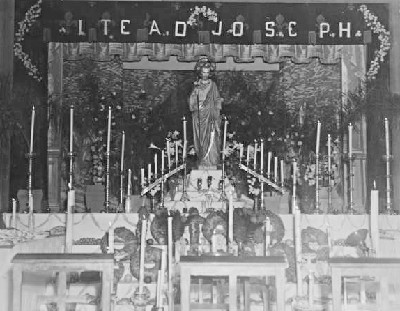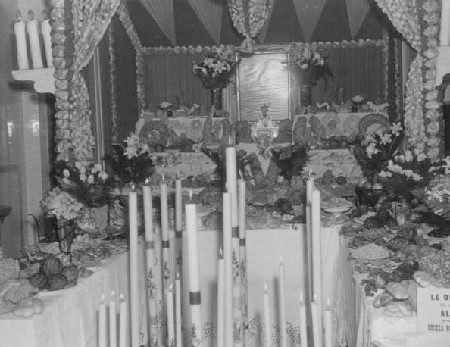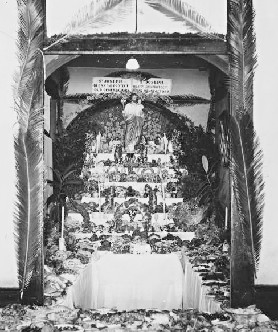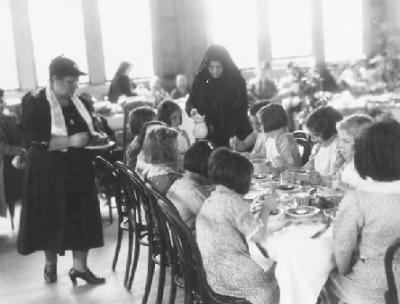| St. Joseph's Altars in New Orleans |
| St. Joseph's Church on Tulane Avenue, pictured when the city was flooded after the levee failures in 2005. The church was constructed between 1869-1890 and is the largest church in the city. For many years it was the scene of a large St. Joseph's Altar. This photo is thanks to Kevin Himel, whose grandparents were married in this church. |
Symbols abound on St. Joseph's Altars: Breads baked in the form of fish represent the
Lenten Season. Those in the form of carpenter's tools allude to Joseph's occupation as a
carpenter. Other symbols often used as a form for bread or other baked goods are:
sandals, staff, chalice, dove, lamb, cross, a crown of thorns, palms. Figs, olives and
grapes are used, referring to the orchards and vineyards of Sicily. Breadcrumbs are
served as seasoning to symbolize sawdust. Cannolis and biscotti are plentiful. Palm
leaves, flowers, citrus fruit and Easter eggs, often nestled in Spanish moss, are used to
decorate.
The food is served to the public and all of the proceeds are donated to the needy (no
money is reimbursed to the people who prepare the food, everything must be donated).
St. Joseph's Day Altars represent the reenactment of a promise made and kept to St.
Joseph for delivery from a devastating famine in medieval Sicily. The altars are a way of
giving thanks and, also, giving help to the needy. In some cases, the food is not sold, but
only viewed by the public, and then, the food itself is distributed to those in need.
The "lucky fava bean" is one of the most well-known customs and comes from the time of
the famine in Sicily when all the crops withered and died, except for the fava bean, which
flourished and enabled the citizens to live through the famine.
Because of the rich and varied cultural heritages in New Orleans, the month of March
provides unique opportunities to: celebrate with the Irish community on March 17th, when
the Irish Channel St. Patrick's Day Club hosts its parade; with the Italian community on
March 19th, when the Italian-American Marching Club hosts its parade; and on what is
known as Super Sunday (the Sunday nearest St. Joseph's Day), when the uptown and
downtown tribes of the Mardi Gras Indians get together for a celebration (the only day
besides Mardi Gras when you can catch a glimpse of the beautifully costumed Indians).
All this, barely after the city has recovered from Mardi Gras festivities.
The thing I loved best about growing up in New Orleans was that every day provided an
opportunity for something unique to happen. The loveliest surprises can happen on a day
when, for everyone else in the nation, it's just plain old Tuesday.
-- Nancy
Lenten Season. Those in the form of carpenter's tools allude to Joseph's occupation as a
carpenter. Other symbols often used as a form for bread or other baked goods are:
sandals, staff, chalice, dove, lamb, cross, a crown of thorns, palms. Figs, olives and
grapes are used, referring to the orchards and vineyards of Sicily. Breadcrumbs are
served as seasoning to symbolize sawdust. Cannolis and biscotti are plentiful. Palm
leaves, flowers, citrus fruit and Easter eggs, often nestled in Spanish moss, are used to
decorate.
The food is served to the public and all of the proceeds are donated to the needy (no
money is reimbursed to the people who prepare the food, everything must be donated).
St. Joseph's Day Altars represent the reenactment of a promise made and kept to St.
Joseph for delivery from a devastating famine in medieval Sicily. The altars are a way of
giving thanks and, also, giving help to the needy. In some cases, the food is not sold, but
only viewed by the public, and then, the food itself is distributed to those in need.
The "lucky fava bean" is one of the most well-known customs and comes from the time of
the famine in Sicily when all the crops withered and died, except for the fava bean, which
flourished and enabled the citizens to live through the famine.
Because of the rich and varied cultural heritages in New Orleans, the month of March
provides unique opportunities to: celebrate with the Irish community on March 17th, when
the Irish Channel St. Patrick's Day Club hosts its parade; with the Italian community on
March 19th, when the Italian-American Marching Club hosts its parade; and on what is
known as Super Sunday (the Sunday nearest St. Joseph's Day), when the uptown and
downtown tribes of the Mardi Gras Indians get together for a celebration (the only day
besides Mardi Gras when you can catch a glimpse of the beautifully costumed Indians).
All this, barely after the city has recovered from Mardi Gras festivities.
The thing I loved best about growing up in New Orleans was that every day provided an
opportunity for something unique to happen. The loveliest surprises can happen on a day
when, for everyone else in the nation, it's just plain old Tuesday.
-- Nancy
| The link to this page is: http://www.thepastwhispers.com/NO_StJoseph.html Back to Old New Orleans Whispers - Home |
My memories of the St. Joseph's Altars I attended as a child are filled with
wonder...wonder at the sheer amount and assortment of food, and wonder at
the intricately sculpted creations, especially the baked goods. The displays
were always amazing. And the crafters were, beyond doubt, some of the most
skilled and talented bakers (and artists) I'd ever seen. That still holds true
today.
The custom of preparing altars for St. Joseph's Day (March 19) was brought to
New Orleans by Sicilian immigrants in the 1800's. Because of the large
population of Sicilians in the city, the tradition survived and flourished. This,
also, explains why, in the United States, the custom is almost exclusive to
New Orleans. While most immigrants from Naples sailed to New York or other
eastern seaboard cities, most Sicilians sailed from Palermo to New Orleans.
According to the Census Bureau, between 1850 and 1870, New Orleans
contained more Italian citizens than any other city in the U.S. In 1910, eighty
per cent of the population of the city's French Quarter was Italian! Before the
levee failures in 2005, there were 200,000 Americans of Italian descent living
in New Orleans and its suburbs, making Italians the largest ethnic group in
the city. This significant population of Italian-Americans is family-, church-,
service- and tradition-oriented. So it shouldn't be a surprise that a custom
like the St. Joseph's Altar still thrives and has become such an important
event in the cultural life of the city.
wonder...wonder at the sheer amount and assortment of food, and wonder at
the intricately sculpted creations, especially the baked goods. The displays
were always amazing. And the crafters were, beyond doubt, some of the most
skilled and talented bakers (and artists) I'd ever seen. That still holds true
today.
The custom of preparing altars for St. Joseph's Day (March 19) was brought to
New Orleans by Sicilian immigrants in the 1800's. Because of the large
population of Sicilians in the city, the tradition survived and flourished. This,
also, explains why, in the United States, the custom is almost exclusive to
New Orleans. While most immigrants from Naples sailed to New York or other
eastern seaboard cities, most Sicilians sailed from Palermo to New Orleans.
According to the Census Bureau, between 1850 and 1870, New Orleans
contained more Italian citizens than any other city in the U.S. In 1910, eighty
per cent of the population of the city's French Quarter was Italian! Before the
levee failures in 2005, there were 200,000 Americans of Italian descent living
in New Orleans and its suburbs, making Italians the largest ethnic group in
the city. This significant population of Italian-Americans is family-, church-,
service- and tradition-oriented. So it shouldn't be a surprise that a custom
like the St. Joseph's Altar still thrives and has become such an important
event in the cultural life of the city.
| Only in New Orleans: An Italian offering, featuring a French fleur-de-lis. |
| An altar set up at Brocato's Ice Cream Shop on Carrollton Avenue. A photo of an altar set up at Brocato's in 1942 can be seen further down on the page. |
| Above, St. Joseph's Altar, Brocato's Ice Cream Shop on Ursuline Street, 1942. Below, St. Joseph's Altar at Mother Cabrini's Day Nursery, St. Philip and Royal Streets, 1930's. |
| Above, and two pictures below, Feast of St. Joseph at Sacred Heart Convent and Orphanage, 3400 Esplanade Avenue, 1940 |
Thanks to Joan McConnell for sharing the three photos directly above and the following
1940 newspaper article about the St. Joseph Altar at Sacred Heart Orphanage:
The entire auditorium had been turned into an altar of delectable foods such as stuffed
artichokes, eggplants, fried fish, relishes, salads, layer cakes and candies, cookies iced
in red and green colors iced with anise, caraway seeds, nuts or dried figs, bowls of fresh
fruit, bunches of fresh vegetables, stalks of carduni - each color forming a scheme, from
deep green to bright red and yellow. All this was displayed on two long tables extended
the length of the huge room, forming a horseshoe. At the far end was a life-size statue of
St. Joseph, surrounded by large and small tapers, candelabra and vases filled with white
Easter lilies.
To the left of this altar was a long table flanked by stacks of sugar, rice, beans and flour,
stacked with Italian bread made in every imaginable figure - crescents, circles, crosses,
braids and twists, all sprinkled with caraway seeds. Toward one end were large packages
of macaroni, spaghetti and cavatuni.
The nun in charge called the altar donor, who had been making gravy in the kitchen. Mrs.
Lawrence Orlando was untying her white apron and examining a large burn on her right
arm extending nearly from her wrist to her elbow. "It's nothing," she told the nun, "I was
stirring the gravy for the fish, my arm felt warm and I noticed I had this burn." She was a
rather petite woman dressed in a smart dark blue spring dress. "My husband and I give
this altar every year, this is the tenth one. My prayer was answered and I made the
promise."
"We are going to have eight of the orphans act as saints eat from the altar first, then we
will let the other orphans have the rest. We do this rather than giving the food to the
poor - there are so many orphans right here that we have to feed. The food was donated
by different people."
Mrs. Orlando mentioned that her brother-in-law, Mr. Peter Orlando, held a St. Joseph
Altar at Mother Carbrini nursery on St. Phillip Street.
"This will be the first time that a picture has been made of the altar," the nun, Sister
Regina, said. "If it is a good one and I look fat in my face, I'll send it to my Mama. But, if I
look skinny in my face, I don't want to send it. She worries for me." Her Italian dialect
showed that she was from southern Italy.
"I'm here on Sunday afternoons, if you want to bring my picture next Sunday," Sister
Regina said while showing me out. "God bless you."
1940 newspaper article about the St. Joseph Altar at Sacred Heart Orphanage:
The entire auditorium had been turned into an altar of delectable foods such as stuffed
artichokes, eggplants, fried fish, relishes, salads, layer cakes and candies, cookies iced
in red and green colors iced with anise, caraway seeds, nuts or dried figs, bowls of fresh
fruit, bunches of fresh vegetables, stalks of carduni - each color forming a scheme, from
deep green to bright red and yellow. All this was displayed on two long tables extended
the length of the huge room, forming a horseshoe. At the far end was a life-size statue of
St. Joseph, surrounded by large and small tapers, candelabra and vases filled with white
Easter lilies.
To the left of this altar was a long table flanked by stacks of sugar, rice, beans and flour,
stacked with Italian bread made in every imaginable figure - crescents, circles, crosses,
braids and twists, all sprinkled with caraway seeds. Toward one end were large packages
of macaroni, spaghetti and cavatuni.
The nun in charge called the altar donor, who had been making gravy in the kitchen. Mrs.
Lawrence Orlando was untying her white apron and examining a large burn on her right
arm extending nearly from her wrist to her elbow. "It's nothing," she told the nun, "I was
stirring the gravy for the fish, my arm felt warm and I noticed I had this burn." She was a
rather petite woman dressed in a smart dark blue spring dress. "My husband and I give
this altar every year, this is the tenth one. My prayer was answered and I made the
promise."
"We are going to have eight of the orphans act as saints eat from the altar first, then we
will let the other orphans have the rest. We do this rather than giving the food to the
poor - there are so many orphans right here that we have to feed. The food was donated
by different people."
Mrs. Orlando mentioned that her brother-in-law, Mr. Peter Orlando, held a St. Joseph
Altar at Mother Carbrini nursery on St. Phillip Street.
"This will be the first time that a picture has been made of the altar," the nun, Sister
Regina, said. "If it is a good one and I look fat in my face, I'll send it to my Mama. But, if I
look skinny in my face, I don't want to send it. She worries for me." Her Italian dialect
showed that she was from southern Italy.
"I'm here on Sunday afternoons, if you want to bring my picture next Sunday," Sister
Regina said while showing me out. "God bless you."
